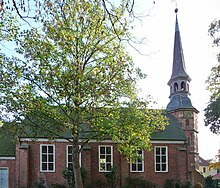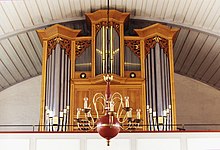Waller Church
The Waller Church is a Protestant parish church in Bremen in the Walle district , Lange Reihe 77. The church building consists of a 1950s nave and a Renaissance tower , both made of brick . It has been a listed building in Bremen since 1973 (see list of cultural monuments in Walle # 0837 ) .
history
The old Michaeliskapelle in front of the Ansgari and Doventor , in which the inhabitants of the villages of Walle and Utbremen had attended church services until then, had been demolished in 1524 by drunken citizens. As a result, the residents of Walle were allowed to build a place of worship in their village. Bremen was in the first lively phase of its Reformation since 1522 . After completion of the "Kerke Sunte Michalis tho Walle" built in 1524, Protestant , initially Lutheran , services were held here from the start . The new church only received a west tower in 1658, and it has been preserved to this day.
In 1725/26 the church was converted into a transversely oriented preacher's hall, based on the pattern of the St. Pauli Church in Bremen Neustadt , as was done in the then Reformed Bremen churches.
During the Second World War , the nave burned down in an air raid in 1942. It was rebuilt from 1952 to 1956 according to the plans of Julius Schulte-Frohlinde . The outer walls were built on the old foundations and in a similar design, but a chancel was added to the east and the Reformation altar position was given up again. The side walls are divided by five windows, which were rectangular as they were before the war, and buttresses . The gable roof has three bat dormers on both sides . Several stone coats of arms adorn the exterior.
tower
When the church was destroyed in 1942, the delicate renaissance tower from 1658 was preserved almost intact. It was erected like an epitaph to commemorate the tomb of the knight Christoffer Ludwig Raschius von Segnitz (1584–1645), who died in Walle . The knight was last in the service of the Swedish crown at court and during the war as "Secret Councilor of the Protestant (Swedish) Imperial Court" and before that "Assessor of the Lower Saxony and Westphalian Empire Director". The Middle Elvish knight was last tenant of the Walle estate. However, after excavations in 1952, the grave was not below, but next to the tower.
The octagonal tower rises on a square base. The shaft is divided by three surrounding sandstone ledges, its corners decorated with sandstone blocks. The roof consists of a French hood , a lantern and a pointed helmet .
Interior space
At that time, the bright interior was spanned by a flat ceiling, with the character from the time it was built as a Reformed church. A gallery stood on three sides. The altar and pulpit were originally located on the north side wall of the transverse church.
After 1952, the church pews are oriented towards the altar on the east side. The organ is located on the gallery on the west side. Today the ceiling is shaped like a flat barrel vault made of wood.
organ
In 2002 the Winold van der Putten workshop ( Finsterwolde , Netherlands) built an organ in the north German-Dutch style of the 17th century on the western gallery . The two-manual instrument has 26 registers in main work, breast work, choral work and pedal.
The organs by Theodorus Faber in Zeerijp and Coevorden served as a model . The design of the prospectus of the main work is based on Coevorden, the construction of the registers of the main work on the organ in Buttforde ( Joachim Richborn , 1681), the registers of the breastworks on the small organ of the Jakobikirche in Lübeck ( Friedrich Stellwagen , 1636–1637) and the Pedal register to Zeerijp (Theodorus Faber, 1651), Buttforde, Stralsund / St. Marien (Friederich Stellwagen, 1653–1659) and to Stade / St. Cosmae ( Berendt Hus , 1669–1673 or 1675 ?; Arp Schnitger , 1688). Harald Vogel , Gebhard Kaiser (1921–2009), Ibo Ortgies and Daniela Staiger worked as consultants for the conception .
The organ has two different pitches and temperatures. The 23 registers of the Hauptwerk, Brustwerk and pedal are medium-tone ( 1 ⁄ 4 syntonic comma ) and have the pitch of a 1 = 415 Hz, which was common in the 17th and 18th centuries (e.g. as the concert pitch of the Bach era). The tones dis and a flat are also available as subsemitonies in the form of divided upper keys. In the manuals there are the subsemitonies from the small octave up to and including D-flat 1 , in the pedal they are only in the small octave. In addition, there is the option of switching between the tones b-flat and a-sharp, using a mechanism designed as a stop. The organ therefore has up to 15 tones per octave in these three works. In this way, on the one hand, the limited scope of the tones or keys available in the classic mid-range is expanded. On the other hand, the instrument can also accompany an ensemble at the pitch of the common chorus tone common in the 17th and 18th centuries (here a 1 = 464 Hz) - for this the organist has to transpose the continuo part upwards by a whole tone. A note as a sharp on the keyboard then corresponds to the G sharp in the concert pitch, so that the usual mid-tone frame for music up to around 1700 can be represented.
During the construction phase, additional requests arose early on in the community that it should also be possible to accompany ensembles that use the modern standard concert pitch. The organ builder was able to meet these wishes by additionally building three registers as choral works, which are played from the second manual and have a pitch of a 1 = 440 Hz. These registers are well-tempered and are therefore usually not played together with the other registers.
The disposition is as follows:
|
|
|
|
||||||||||||||||||||||||||||||||||||||||||||||||||||||||||||||||
- Coupling : I / P
- Secondary and effect registers : tremulant , Zimbelstern , drum, bird cries
- Playing aids : 3 shut-off valves , switch Ais / B
graveyard
The former church cemetery is now a green area with five old tombstones from before 1646 to around 1900 in the north. In the church tower is a recessed grave slab from 1646. The municipal Waller cemetery from 1875 is nearby.
Parish
The current activities of the parish Walle are u. a .: RAZ ( Ran to the Future ), the day care center “Schnecke”, play circle, the day care center “Fienchen”, the senior café, women's groups, the community choir and the Christian scouts. The parish hall is located in the nearby Ritter-Raschen-Straße.
literature
- Georg Dehio : Handbook of the German art monuments - Bremen / Lower Saxony . Deutscher Kunstverlag, Munich / Berlin 1977, ISBN 3-422-00348-7 , p. 64
- Rudolf Stein : Village churches and farmhouses in the Bremen region. Bremen 1967, DNB 458222070 .
- Bodo Grotheer: 340 years of the Waller church tower .
Individual evidence
- ↑ In memory of the six hundred year jubilee of the St. Ansgariikirche in 1843, p. 44f. (Google digitized version)
- ↑ Johann Hermnann Duntze, history of the free city of Bremen (1845), Vol 1, p 200. The other Michelis-Capelle (BUB - Digital Collections)
- ↑ Bremen State Office for Monument Preservation: Enlargeable photos on the history of the building: the penultimate one after the bombing of 1942, the last one after the burned roof structure was removed
- ^ Translation from the Waller Kirchbuch, 1764.
- ^ Daniela Staiger-Ortgies: The concept of the Waller organ. P. 3, accessed on February 2, 2018 (PDF file; 228 kB).
- ^ Organ in Bremen-Walle , accessed on February 2, 2018.
Web links
Coordinates: 53 ° 6 ′ 11.6 ″ N , 8 ° 46 ′ 36.5 ″ E



